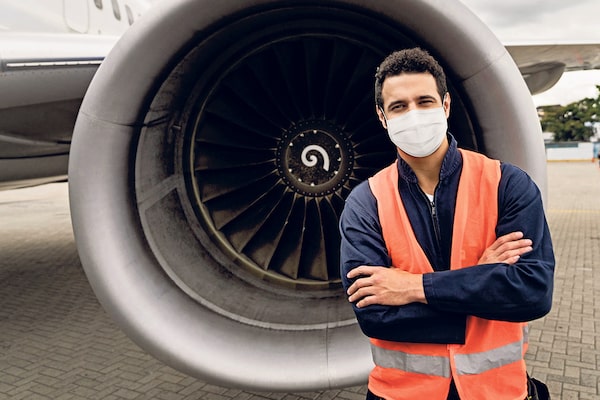
iStockPhoto / Getty Images
It may have been mere coincidence, but on the same day leaders of Canada’s aerospace industry published an open letter to Prime Minister Justin Trudeau and two of his Cabinet colleagues urging government action to support the sector, parliament’s Standing Committee on Industry, Science and Technology approved a motion to spend time studying how to do just that.
The open letter to Mr. Trudeau, Finance Minister Chrystia Freeland and Industry Minister Navdeep Bains was signed by Aerospace Industries Association of Canada (AIAC) president and CEO Jim Quick and sector leaders in Ontario, Quebec, Manitoba and Atlantic Canada.
It follows repeated calls in recent years for government to develop and implement an aerospace industry strategy for keeping the country competitive in a global sector that is rapidly outpacing Canada, which was at one time among the world’s top five aerospace players.
In their open letter, the industry leaders note that aerospace is a “vital industry” active in every region of Canada and contributing $28-billion in annual GDP, but is now suffering and requires action by government.
“As you are aware, AIAC released our Vision 2025 document, outlining the urgent need for government action on six key recommendations, over a year ago. The COVID-19 pandemic has made the situation even more critical,” the leaders wrote, adding that protecting an industry responsible for 235,000 jobs needs to become a priority.

"If nothing is done and if Canada continues to not have a focused approach to the sector in a world where other countries do, we could lose up to 60,000 jobs in the next five years" - Rahul Gangal, Partner at Roland BergerSUPPLIED
Industry experts agree.
Rahul Gangal, a partner in the Toronto office of Roland Berger, a global business consultancy, advises clients from a range of industries, including aerospace. He says the Canadian aerospace sector needs a sector-specific strategy, a cash infusion to support the industry and build long-term competitiveness, support to establish an efficient production base, and recognition.
Mr. Gangal believes Canadian aerospace lacks the recognition given to competing sectors in other countries, which puts it at a disadvantage.
“The aerospace industry across the world is present in a few countries, and each of those countries has taken it upon themselves to preserve what they have as a global leader, but also grow the industry in the long run so that their competitiveness on a global scale is not eroded substantially,” he says. “They do that by acknowledging the contribution that the aerospace sector makes to the economy, which I think is a bit amiss in Canada. So, as Bob Marley would say, ‘It needs a little more love.’”
Mr. Gangal agrees that Canada needs an aerospace strategy.
“Canada seems to be the only country that does not have a thought-out approach specific to the sector. If you look at Canada’s peers, countries like France, Germany and the UK, the large U.S. market, or emerging markets like India and China, all of them have predefined approaches to the sector because they consider it a national asset,” he says.
Canada, on the other hand, in spite of a rich aerospace legacy spanning more than 80 years, and with residual strengths in some industry segments globally, still has no sector-specific strategy.
“So what the industry is saying is let us at least get the same treatment as our peers in other countries and acknowledgement of the sector’s considerable achievements over a long period of time,” adds Mr. Gangal.
While Canada’s aerospace industry has been negatively impacted by COVID-19, its global standing was slipping long before the pandemic hit, he says.
“COVID has made it a sudden death situation. If nothing is done and if Canada continues to not have a focused approach to the sector in a world where other countries do, we could lose up to 60,000 jobs in the next five years and $12-billion to $18-billion in exports – and it’s a very difficult business to bring back once you lose it,” says Mr. Gangal.
But while jobs losses five years out may seem far off, the problem is “here and now,” he adds, pointing out that within two years 20,000 to 25,000 jobs could be lost without immediate decisive action.
“The question for Canada is whether the country can afford to lose many tens of thousands of high-paying, high-skilled jobs simply because the response was not very well planned,” he says.
BY THE NUMBERS (Data for 2018)
- $20-billion+ Contributed to Canadian GDP by the aerospace industry and its value chain
- 160,000 Direct and indirect jobs attributable to the aerospace sector
- 51% Quebec’s share of manufacturing jobs in Canada’s aerospace sector
- 93 Percentage of Canadian aerospace manufacturing firms that were exporters
- 1 Canada’s sub-segment global rank in the production of civil flight simulators, helicopter engines and turbo-prop engines
- $1.4-billion The Canadian aerospace sector’s investment in R&D
(Source: State of Canada’s Aerospace Industry – 2019 Report presented by Innovation, Science and Economic Development Canada and the Aerospace Industries Association of Canada)
Produced by Randall Anthony Communications. The Globe’s editorial department was not involved in its creation.